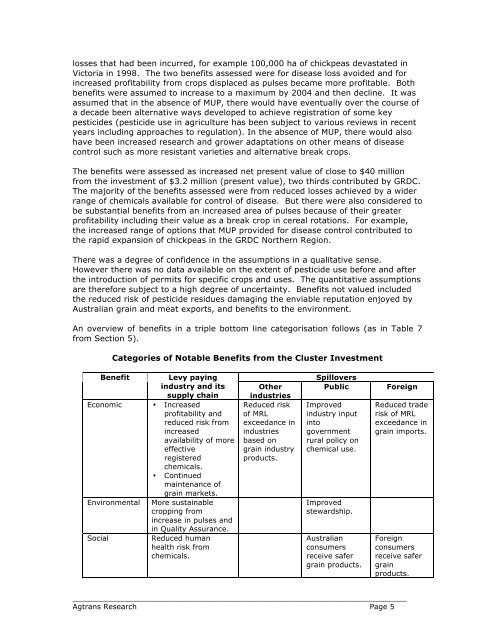An Economic Analysis of GRDC Investment in Minor Use Chemicals
An Economic Analysis of GRDC Investment in Minor Use Chemicals
An Economic Analysis of GRDC Investment in Minor Use Chemicals
Create successful ePaper yourself
Turn your PDF publications into a flip-book with our unique Google optimized e-Paper software.
losses that had been <strong>in</strong>curred, for example 100,000 ha <strong>of</strong> chickpeas devastated <strong>in</strong><br />
Victoria <strong>in</strong> 1998. The two benefits assessed were for disease loss avoided and for<br />
<strong>in</strong>creased pr<strong>of</strong>itability from crops displaced as pulses became more pr<strong>of</strong>itable. Both<br />
benefits were assumed to <strong>in</strong>crease to a maximum by 2004 and then decl<strong>in</strong>e. It was<br />
assumed that <strong>in</strong> the absence <strong>of</strong> MUP, there would have eventually over the course <strong>of</strong><br />
a decade been alternative ways developed to achieve registration <strong>of</strong> some key<br />
pesticides (pesticide use <strong>in</strong> agriculture has been subject to various reviews <strong>in</strong> recent<br />
years <strong>in</strong>clud<strong>in</strong>g approaches to regulation). In the absence <strong>of</strong> MUP, there would also<br />
have been <strong>in</strong>creased research and grower adaptations on other means <strong>of</strong> disease<br />
control such as more resistant varieties and alternative break crops.<br />
The benefits were assessed as <strong>in</strong>creased net present value <strong>of</strong> close to $40 million<br />
from the <strong>in</strong>vestment <strong>of</strong> $3.2 million (present value), two thirds contributed by <strong>GRDC</strong>.<br />
The majority <strong>of</strong> the benefits assessed were from reduced losses achieved by a wider<br />
range <strong>of</strong> chemicals available for control <strong>of</strong> disease. But there were also considered to<br />
be substantial benefits from an <strong>in</strong>creased area <strong>of</strong> pulses because <strong>of</strong> their greater<br />
pr<strong>of</strong>itability <strong>in</strong>clud<strong>in</strong>g their value as a break crop <strong>in</strong> cereal rotations. For example,<br />
the <strong>in</strong>creased range <strong>of</strong> options that MUP provided for disease control contributed to<br />
the rapid expansion <strong>of</strong> chickpeas <strong>in</strong> the <strong>GRDC</strong> Northern Region.<br />
There was a degree <strong>of</strong> confidence <strong>in</strong> the assumptions <strong>in</strong> a qualitative sense.<br />
However there was no data available on the extent <strong>of</strong> pesticide use before and after<br />
the <strong>in</strong>troduction <strong>of</strong> permits for specific crops and uses. The quantitative assumptions<br />
are therefore subject to a high degree <strong>of</strong> uncerta<strong>in</strong>ty. Benefits not valued <strong>in</strong>cluded<br />
the reduced risk <strong>of</strong> pesticide residues damag<strong>in</strong>g the enviable reputation enjoyed by<br />
Australian gra<strong>in</strong> and meat exports, and benefits to the environment.<br />
<strong>An</strong> overview <strong>of</strong> benefits <strong>in</strong> a triple bottom l<strong>in</strong>e categorisation follows (as <strong>in</strong> Table 7<br />
from Section 5).<br />
Categories <strong>of</strong> Notable Benefits from the Cluster <strong>Investment</strong><br />
Benefit<br />
Levy pay<strong>in</strong>g<br />
<strong>in</strong>dustry and its<br />
supply cha<strong>in</strong><br />
<strong>Economic</strong> • Increased<br />
pr<strong>of</strong>itability and<br />
reduced risk from<br />
<strong>in</strong>creased<br />
availability <strong>of</strong> more<br />
effective<br />
registered<br />
chemicals.<br />
• Cont<strong>in</strong>ued<br />
ma<strong>in</strong>tenance <strong>of</strong><br />
gra<strong>in</strong> markets.<br />
Environmental More susta<strong>in</strong>able<br />
cropp<strong>in</strong>g from<br />
<strong>in</strong>crease <strong>in</strong> pulses and<br />
<strong>in</strong> Quality Assurance.<br />
Social<br />
Reduced human<br />
health risk from<br />
chemicals.<br />
Other<br />
<strong>in</strong>dustries<br />
Reduced risk<br />
<strong>of</strong> MRL<br />
exceedance <strong>in</strong><br />
<strong>in</strong>dustries<br />
based on<br />
gra<strong>in</strong> <strong>in</strong>dustry<br />
products.<br />
Spillovers<br />
Public<br />
Improved<br />
<strong>in</strong>dustry <strong>in</strong>put<br />
<strong>in</strong>to<br />
government<br />
rural policy on<br />
chemical use.<br />
Improved<br />
stewardship.<br />
Australian<br />
consumers<br />
receive safer<br />
gra<strong>in</strong> products.<br />
Foreign<br />
Reduced trade<br />
risk <strong>of</strong> MRL<br />
exceedance <strong>in</strong><br />
gra<strong>in</strong> imports.<br />
Foreign<br />
consumers<br />
receive safer<br />
gra<strong>in</strong><br />
products.<br />
_________________________________________________________________<br />
Agtrans Research Page 5

















